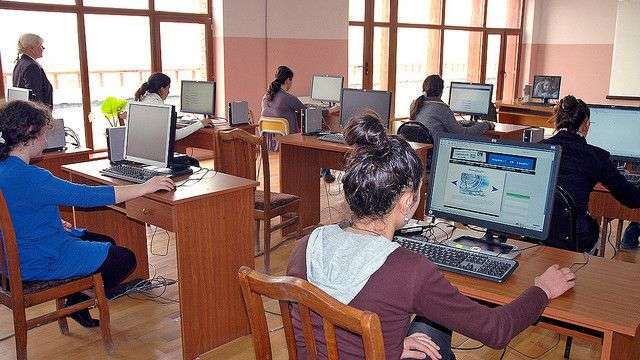In the rapidly evolving education landscape, gadgets have emerged as powerful tools with potential and challenges. As technology integration in education becomes more prevalent, it’s crucial to explore the multifaceted impact of gadgets on the learning experience. Regarding gadgets in education, weighing the pros and cons is critical. On the one hand, they can boost engagement and facilitate personalized learning. On the other hand, they can be a source of distraction and pose health risks.
Enhanced Engagement and Interaction
Interactive learning apps, a product of technological advancement, have redefined how students engage with educational content. Through the gamification of education, concepts that once seemed daunting can now be approached playfully. Gamified quizzes, challenges, and simulations foster a sense of competition and enhance problem-solving skills. This dynamic engagement draws students into subjects that might have otherwise appeared monotonous.
Access to Vast Information
The internet, a treasure trove of information, has revolutionized the educational landscape. Gadgets provide students immediate access to online resources, ranging from research articles to educational videos. The digital shift has ushered in an era of e-books and digital libraries, making learning materials accessible on the go. This democratization of knowledge transcends traditional learning constraints, fostering a culture of independent and lifelong learning.
Personalized Learning
Adaptive learning platforms leverage artificial intelligence to tailor educational content to individual student needs. This personalized approach accommodates each student’s learning pace and style. Customized study paths empower students to delve deeper into subjects of interest, promoting a higher level of engagement and understanding. The integration of gadgets allows educators to cater to diverse learning profiles within a single classroom.
Visual and Multisensory Learning
Educational videos and animations, once a rarity, have become integral to modern pedagogy. Gadgets facilitate the incorporation of visual and multisensory elements, enhancing comprehension and knowledge retention. Complex concepts are simplified through animated diagrams, 3D models, and interactive simulations. Moreover, augmented and virtual reality have taken experiential learning to new heights, enabling students to explore historical sites, microscopic worlds, and fantastical realms without leaving the classroom.
Remote Learning and Flexibility
The boom in online learning can be attributed mainly to the use of technology. Thanks to virtual classrooms, students can participate in group discussions, collaborate on projects, and access learning materials without leaving their homes, no matter where they are located. Asynchronous learning options are also available, particularly beneficial for students with varying schedules or those who need to balance their education with other responsibilities. This flexibility benefits non-traditional learners and working professionals who want to improve their skills.
Distraction and Reduced Focus
However, the allure of gadgets and the interconnected world they provide can also hinder the learning process. Social media platforms, entertainment apps, and constant notifications can easily divert students’ attention from educational tasks. The challenge lies in cultivating the discipline to stay focused and resist the temptation to switch jobs frequently. Finding the right balance between utilizing gadgets for learning and avoiding distracting aspects is critical.
Health Concerns
The prolonged use of gadgets can lead to digital eye strain, a condition characterized by discomfort, dryness, and fatigue. Additionally, the sedentary lifestyle associated with prolonged gadget use contributes to various health issues, including obesity and musculoskeletal problems. Educators and students must prioritize digital wellness, incorporating frequent screen breaks and physical activity into their routines to mitigate these potential health risks.
Dependence on Technology
As education increasingly relies on gadgets, concerns about the potential erosion of critical thinking and problem-solving skills emerge. Overreliance on automated calculations and information retrieval tools may diminish students’ capacity to think critically, analyze complex problems, and develop creative solutions. Striking a balance between efficiently leveraging technology and nurturing fundamental cognitive skills is essential to produce well-rounded learners.
Privacy and Security Risks
The digital realm introduces a new set of challenges related to privacy and security. Data breaches and cyberattacks can compromise sensitive student information, leading to identity theft and other malicious activities. Moreover, the monitoring and surveillance inherent in technology-supported education raise ethical concerns regarding student privacy. Institutions must adopt robust cybersecurity measures and transparent data-handling practices to protect students’ confidential information.
Technological Inequality
While gadgets have the potential to level the playing field, there remains a significant gap in technological accessibility. Socioeconomic disparities create a digital divide, where students from disadvantaged backgrounds may lack the necessary gadgets and reliable internet connectivity to engage in digital learning fully. Addressing this divide requires concerted efforts, such as providing subsidized gadgets and expanding internet access initiatives in underserved communities.
Balancing the Pros and Cons
Achieving a harmonious integration of gadgets into education necessitates a multifaceted approach. Schools can implement digital wellness programs to educate students about responsible tech usage. Encouraging regular breaks, outdoor activities, and mindfulness practices can counter the adverse effects of excessive screen time. Additionally, gadgets should be viewed as complementary tools rather than replacements for traditional teaching methods, allowing educators to effectively blend digital and in-person instruction.
Integrating Gadgets as Complementary Tools
Blended learning approaches capitalize on the strengths of both technology and traditional pedagogy. Educators can balance engaging digital content and face-to-face interaction by integrating gadgets as supplementary resources. This approach caters to diverse learning styles and accommodates individual preferences, ensuring that the benefits of technology are harnessed while preserving the essence of human connection in education.
Teacher Training and Digital Literacy
Empowering educators with the necessary digital skills is paramount to harnessing the full potential of gadgets in education. Professional development programs should prioritize equipping teachers with the knowledge and confidence to navigate and integrate technology seamlessly. Adapting pedagogical strategies to leverage gadgets effectively requires a deep understanding of creating engaging digital content, fostering collaboration, and providing meaningful feedback in a digital learning environment.
Future Trends and Possibilities
As technology advances, the trajectory of gadgets in education holds exciting possibilities. Adaptive AI tutors are poised to provide personalized guidance and support, adjusting their approach based on real-time student performance data. Predictive learning analytics can anticipate students’ learning needs and offer timely interventions, enhancing the educational experience. These trends can potentially revolutionize how education is delivered and experienced.
Seamless Integration of Augmented Reality
Augmented reality (AR) can potentially revolutionize education by superimposing digital data onto the real-world environment. Virtual field trips can transport students to historical events, remote ecosystems, and cultural landmarks, enhancing experiential learning. Moreover, AR can foster real-world problem-solving skills by immersing students in interactive scenarios that require critical thinking and collaboration. This integration can make education more engaging, immersive, and impactful.
Ethical Considerations and Frameworks
As gadgets reshape education, ethical considerations must guide their deployment. Safeguarding data privacy and obtaining informed consent from students and parents are fundamental ethical responsibilities. Additionally, technological advancements should align with human values, promoting empathy, equity, and inclusivity. Developing frameworks that balance technological innovation with ethical considerations will ensure that the evolution of education remains grounded in the principles of responsible and compassionate progress.
Conclusion
The impact of gadgets on education is significant, presenting both opportunities and challenges. Integrating technology thoughtfully is complex, involving personalized learning, engagement, and ethical considerations. Navigating this path requires mindful adoption, informed choices, and a commitment to ethics.
In this evolving landscape, the collaboration of human intellect and technology will define learning’s future. Notably, the fusion of branding and affiliate marketing adds a unique dimension. Branding educational gadgets and aligning them with affiliate strategies can enhance learning experiences while creating sustainable ecosystems.
This synergy extends beyond education to occasions like weddings. Branded tech accessories can elevate celebrations, showcasing innovation within cherished traditions. Embracing this fusion enriches lives, shaping learning and celebrations alike.
FAQs: The Impact of Gadgets on Education: Pros and Cons
1. How do gadgets enhance engagement and interaction in education, especially online mock tests? In the rapidly evolving education landscape, gadgets have become powerful tools, especially in the context of online mock tests. Students can dynamically engage with educational content through interactive learning apps and gamification. Gamified quizzes, challenges, and simulations, including online mock tests, foster competition and enhance problem-solving skills, making challenging concepts more approachable and engaging.
2. How has the internet transformed education accessibility, particularly concerning online mock tests? Gadgets have brought about a significant transformation in education, particularly regarding online mock tests. With immediate access to the internet, students can easily participate in online mock tests and gain insights into their performance. The internet provides access to many resources, research articles, and educational videos, enhancing preparation.
3. What is personalized learning through adaptive platforms, and how does it relate to online mock tests? Adaptive learning platforms powered by AI are closely connected to customized education, especially in the context of online mock tests. These platforms tailor educational content to suit each student’s needs, offering customized practice questions and challenges in fake test formats. This approach enhances engagement and allows students to focus on areas that require improvement.
4. How do visual and multisensory learning impact education, particularly in the context of online mock tests? Gadgets are pivotal in integrating visual and multisensory learning, even in online mock tests. Educational videos, animations, and interactive simulations in online mock tests simplify complex concepts, ensuring better comprehension and retention. Augmented reality experiences, which can be incorporated into online mock tests, take the learning experience to new levels by immersing students in realistic scenarios.
5. What challenges are associated with gadget use in education, specifically when considering online mock tests?
While gadgets offer numerous advantages, including online mock tests, they pose challenges that need careful consideration. These challenges include potential distractions from social media and entertainment apps, primarily when students should be focusing on their online mock test preparations. Additionally, extended use of gadgets for online mock tests can contribute to digital eye strain and a sedentary lifestyle, emphasizing the importance of maintaining a balanced approach to learning.



[…] journey of ingenious gadgets traces back to the ingenuity of human minds. Throughout history, invention has been propelled […]
[…] influence of gadgets on our daily lives is undeniable. These remarkable devices have transformed how we communicate, […]